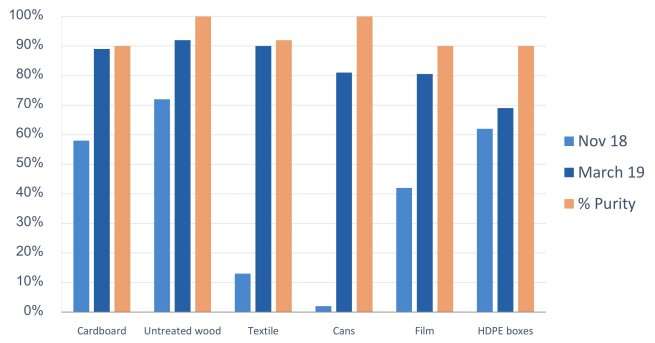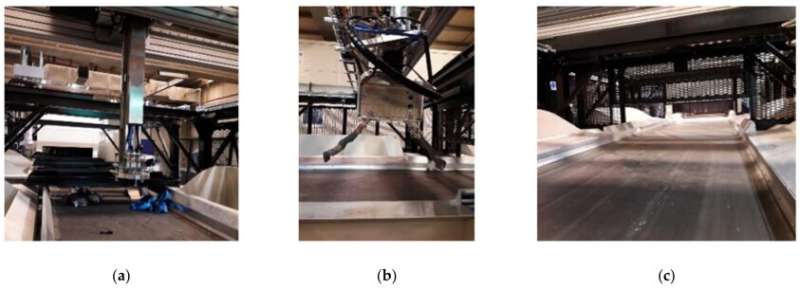Mining garbage and the circular economy

Over the last century, we have mined more and more raw materials, and manufactured products from those materials. Increased prices for mined raw materials and improved recycling technology have enabled some industries to rely more on recycled materials than ever before. A report by Bob Tita in the Wall Street Journal last week detailed this trend in the aluminum business. According to Tita:
"U.S. aluminum consumption grew by 11% last year, bouncing back from 2020's pandemic-influenced reduction, according to the Aluminum Association trade group… To meet rising demand, aluminum companies are doubling down on recycling, melting more scrap to increase their output of aluminum… More than 40% of the country's aluminum supply already is produced this way, making the U.S. one of the world's biggest consumers of aluminum scrap. The U.S. is one of the world's biggest exporters of aluminum scrap, too, with 2 million metric tons of it sent overseas last year, according to government data…Melting scrap for aluminum uses about 90% less electricity than producing aluminum in a smelter from refined bauxite ore, analysts said."
One problem with recycling is that our current system requires humans to sort garbage and relies on markets for raw materials that tend to fluctuate. One element of a solution to this is a more automated system of waste sorting and waste mining. Early stages of the development of this technology are now underway. According to Lori Ioannou and Magdelena Petrova of CNBC:
"U.S. companies and researchers are developing AI-assisted robotic technology that can work with humans in processing plants and improve quality control. The goal is to have robots do a better job at sorting garbage and reduce the contamination and health hazards human workers face in recycling plants every day. Sorting trash is a dirty and dangerous job. Recycling workers are more than twice as likely as other workers to be injured on the job…The profession also has high fatality rates. The way the robots work is simple. Guided by cameras and computer systems trained to recognize specific objects, the robots' arms glide over moving conveyor belts until they reach their target. Oversized tongs or fingers with sensors that are attached to the arms snag cans, glass, plastic containers, and other recyclable items out of the rubbish and place them into nearby bins."

A recent academic study by Henning Wilts et al. published in the journal Resources analyzed an effort to utilize Artificial Intelligence in waste sorting and was titled "Artificial Intelligence in the Sorting of Municipal Waste as an Enabler of the Circular Economy."
These analysts found that AI-enabled robots could improve working conditions for human waste management workers and improve the purity of the waste stream.
This technology is relatively new but holds enormous potential. There are a number of economic factors that contribute to the likelihood that waste management will eventually be dominated by waste mining and resource recovery. First, the cost of managing solid waste is increasing. The land for landfilling is becoming more expensive and, in many areas, simply not available. More and more waste is being processed by some form of technology. It is obviously desirable if the expense of this technology and waste management process could be offset by the sale of resources. Second, the cost of mining raw materials is growing as these materials must be mined from less readily accessible locations and due to the expense of complying with regulations protecting the environment near mines which are finally, if slowly, being implemented. All of this provides a potential economic base for recycling.
The environmental case for the circular economy is obvious. We need to end the linear model of mining, using and discarding resources. This model damages the environment and results in ever-increasing costs. Raw materials will increase in price, and the cost of remediating toxics in the biosphere will continue to grow. The linear model may have been workable for a planet of a billion people who did not consume much, but it is unworkable on a planet of eight to ten billion humans consuming the way we do. We are slowly starting to develop a circular economy where "waste" is being redefined as a resource. We have a long way to go before we end the linear economy. Where possible, we need to design consumer items for remanufacturing. Computers and other electronics should be designed to be disassembled for raw materials or should be built to form the base for the next generation of the device. Food and sewage waste should be used to manufacture fertilizer. Some of this resource reuse requires new product design; some requires more advanced waste sorting and waste mining facilities.
The environmentally sound mining of waste streams for resources requires the use of renewable energy. These waste-reuse processes are energy-intensive, and both the financial and environmental costs of utilizing these processes need to be minimized. That means they need to be powered by renewable energy. While waste sorting and mining facilities will be capital intensive, the revenue streams to support these capital expenditures can be generated from the sale of raw materials and by reallocating the current funding allocated to waste transport and tipping fees at dumpsites.
Siting waste mining facilities will be a political nightmare. No one will want to live near these facilities. One possible solution would be to construct these facilities on or near existing landfills, waste transfer stations, or other waste management facilities. The garbage trucks are already driving in. Better-designed facilities might include tunnels and garage structures to reduce the visibility and environmental impact of truck traffic. They should certainly include advanced emission and effluent controls. In the case of landfills, there may come a time when they too will be mined for resources. It might be a good idea to locate waste management and mining operations nearby.
I have been writing about garbage for over two decades. I know that the topic is about as unglamorous as can be. Political leaders are reluctant to be publicly identified with waste problems or waste solutions. No one seems to want to cut a ribbon on a new waste management facility. And yet, an environmentally sustainable city is not possible without a system for handling and hopefully benefiting from the reprocessing of its waste. Aluminum is one metal that has already developed a cost-effective system for reuse. Recycling the rare earth minerals used in electric vehicle batteries has also proven to be highly profitable. In fact, as electric vehicles become more common, we can expect to see them mined for raw materials when they end their useful life.
It is important to understand the way that aluminum has integrated reuse into its business model and how aluminum might lead the way for other industries. As Bob Tita reported in the Wall Street Journal:
"Aluminum beverage cans have some of the best recovery and reuse rates of any recycled household consumer products. About 70% of new cans are made from old cans, according to the Can Manufacturers Institute… Scrap aluminum is becoming more important to the aluminum industry as the number of smelters, which produce virgin aluminum, has been shrinking for years. Six smelters continue to operate in the U.S., down from about two dozen 20 years ago, as executives have said aging equipment and rising electricity costs make them increasingly expensive to operate… Rising scrap prices are providing more incentives for collecting scrap and investing in the equipment to process it. Used beverage cans are trading at $1.38 a pound, up 78% in the past year, according to S&P Global Commodity Insights. The price of old aluminum sheet scrap is 38% higher from a year ago."
Aluminum reuse is not typical of most metals today, but we can expect the same economic logic that worked for aluminum to become common for other materials in coming years. New technology and enlightened leadership will be needed before we will see widespread construction of municipal waste management and material mining facilities. Nevertheless, the construction of such facilities is essential for the development of a circular economy, and the evolution toward a circular economy is a prerequisite for sustainable cities. Artificial intelligence and automation, along with revenues from the sales of recycled materials, should make these facilities financially viable in the near future.
More information: Henning Wilts et al, Artificial Intelligence in the Sorting of Municipal Waste as an Enabler of the Circular Economy, Resources (2021). DOI: 10.3390/resources10040028
This story is republished courtesy of Earth Institute, Columbia University http://blogs.ei.columbia.edu.
















